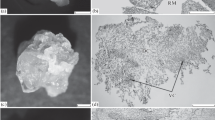Summary
It has been shown that gibberellin-like substances are produced in the scutellum of barley embryos during the first two days of germination (at 25°). This production is not stimulated by mevalonic acid or sugar, but it is inhibited by CCC. On the third day the activity of the scutellum ceases and the axis probably commences to produce gibberellins. Both gibberellic acid and gibberellin A1 appear to be present, the latter predominating.
Similar content being viewed by others
References
Bird, H. L., and C. T. Pugh: A paper chromatographic separation of gibberellic acid and gibberellin A1. Plant Physiol. 33, 45 (1958).
Hayashi, T.: Biochemical studies on the “bakanae” fungus of rice. Part. 6. Effect of gibberellin on the activity of amylase in germinated cereal grains. J. Agric. Chem. Soc. Japan 16, 531 (1940).
Kirsop, B. H., and J. R. A. Pollock: Studies in barley and malt. XII. Interaction between the embryo and the endosperm of barley during malting. J. Inst. Brew. 64, 227 (1958).
Jones, D. F., J. MacMillan, and M. Radley: Plant hormones. III. Identification of gibberellic acid in immature barley and immature grass. Phytochem. 2, 307–314 (1963).
Jones, R. L., and I. D. J. Phillips: Agar-diffusion technique for estimating gibberellin production by plant organs. Nature (Lond.) 204, 497–499 (1964).
Lazer, L., W. E. Baumgartner, and R. V. Dahlstrom: Determination of endogenous gibberellins in green malt by isotope derivative dilution procedures. Agric. and Food Chem. 9, 24 (1961).
Macmillan, J., J. C. Seaton, and P. J. Suter: Plant hormones. II. Isolation and structures of gibberellin A6 and gibberellin A8. Tetrahedron 18, 349–355 (1962).
—, and P. J. Suter: Thin layer chromatography of the gibberellins. Nature. (Lond.) 197, 790 (1963).
Nicholls, P. B., and L. G. Paleg: A barley endosperm bioassay for gibberellins. Nature (Lond.) 199, 823 (1963).
Paleg, L. G.: Physiological effects of gibberellic acid. I and II. Plant Physiol. 35, 293 and 902 (1960).
—, H. Kende, H. Ninnemann, and A. Lang: Physiological effects of gibberellic acid. VIII. The effects of growth retardants on barley endosperm. Plant Physiol. 40, 165–169 (1965).
Radley, M.: The occurrence of gibberellin-like substances in barley and malt. Chem. and Ind. 877 (1959).
Stoddart, J. L.: Studies on the relationship between gibberellin metabolism and daylength in normal and non-flowering red clover. J. exp. Bot. 17, 96–107 (1966).
Whyte, P., and L. C. Luckwill: A sensitive bioassay for gibberellins based on retardation of leaf senescence in Rumex obtusifolius. Nature (Lond.) 210, 1360 (1966).
Yomo, H.: Amylase-activating substance. II. Amylase-activating substance in the culture solution of barley embryo and the extraction of barley green malt. Hakko Kyokaishi 18, 494 (1960).
—, and H. Iinuma: Production of gibberellin-like substance in the embryo of barley during germination. Planta (Berl.) 71, 113–118 (1966).
Author information
Authors and Affiliations
Rights and permissions
About this article
Cite this article
Radley, M. Site of production of gibberellin-like substances in germinating barley embryos. Planta 75, 164–171 (1967). https://doi.org/10.1007/BF00387132
Received:
Issue Date:
DOI: https://doi.org/10.1007/BF00387132




